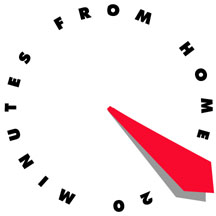 |
|
|||||
| History | ||||||
| In 1987, Carol Covin, a database specialist, was commuting to a consulting assignment from her home in Virginia to a client's site in Maryland. She noticed something interesting. There were just as many cars driving back across the bridge she traveled every day to Virginia as there were traveling with her into Maryland. This meant there were just as many jobs on both sides of the bridge and they were all just trading places twice a day! She started to think about what that meant. If she wanted to leave her job and find one closer to home, how would she do it? She thought about creating a database of all the jobs in the area, organized geographically. If she could draw a circle around her house that was a 20-minute commute, how she would find all the jobs inside that circle. More importantly, how would she find the jobs that required her set of database skills? The first step seemed to be accumulating the jobs listed in the paper every Sunday. Washington, D.C. has more computer jobs than anywhere else in the country, largely because of the federal government's decision in the 1970s to outsource work where possible. This had created an industry quickly filled by companies specializing in providing computer consulting services. These companies were, somewhat fondly, called "beltway bandits", referring to their location within the Route 495 beltway that circles metropolitan Washington, D.C. Most techies then scanned the want-ads every Sunday, just to see what jobs might be available and what skills were hot. She thought she could determine from the ads what companies were looking for and assemble a database of each company's technical environment. But, she quickly learned there were several flaws to this approach. • First, many ads were blind. That is, the company was not identified. A post office box was used as a return address. • Second, more than half the ads were through recruiting agencies. Again, this meant the companies requiring specific skills were not identifiable. • Third, there was no way to tell how important a skill was in the context of a company's technology environment. That is, were they experimenting with a small PC-based project, or was this a major development effort that was part of their mainstream work? • And, finally, there was very little other information about a company. What was their culture like? Was a college degree important? Was overtime in the range of 45 hours a week or 60 hours? Was it a techie-friendly company? Were their projects interesting? There was only one way to find out. Contact the companies directly. In 1988, she did just that. She quit her job in May of 1988 to write the first Covin's job guide - The Computer Professional's Job Guide for the Washington, D.C. Area. Published by Vandamere Press in 1989, the first Covin's job guide sold out its first printing within a few months. Within a year, she had completed the second guide in the series - Covin's New England Computer Job Guide. Covin's Midwest Computer Job Guide, Covin's Southeast Computer Job Guide, and an updated, Covin's Washington Area Computer Job Guide soon followed. In 2000, Covin initiated a nationwide approach to profiling companies, with a companion web site following in mid-2001. • All the profiles from earlier guides are being added to this site, except those companies that have since gone out of business, or been absorbed by other businesses. • Readers should check the copyright date on all profiles. Older profiles might describe some technology that has been replaced, but it is likely the company culture is still intact. • New companies are being added with a new interview format initiated in 2000 that incorporates additional questions techies have asked for. • Periodically, a print version of profiled companies will be published, as a companion to the site. • Companies are now sponsoring the in-depth profiles, and, as always, review the profiles for accuracy. The questions are still determined by surveys of techies and editorial control is maintained by 20 Minutes from Home. |
||||||